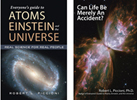|
June 1,
2010 Newsletter
Newsletter on Artificial Life
Some
very exciting advances in synthetic biology were recently announced.
Unfortunately, but not surprisingly, some news media over-hyped these
events as being the "Creation of Life by God 2.0." What really
happened, and what does it mean?
This research is led by
American biologist Dr. J. Craig Venter, the first to sequence the human
genome and generally considered the world’s leading expert in decoding
and synthesizing DNA. Scientists at JCVI (the J. Craig Venter
Institute) removed the DNA from a normal bacterium and replaced it with
man-made DNA that contained one million nucleotide base pairs.

Each
base pair corresponds to one of the four “letters” in the universal
genetic code of all known life: A, C, G, or T. For the first time, an
organism with artificial DNA survived and reproduced, which most agree
qualifies it to be called “alive.”
While the DNA base pairs were
assembled in a lab, the coding was copied from existing natural
bacteria, with the addition of a “watermark” that identified it as
man-made. This is in effect cloning with benefits. While a major
scientific advance, this is not the creation of entirely new life from
scratch.
The new results emphasize the immense complexity of
even the simplest life and how extraordinarily unlikely it is that life
could have arisen by random chance through any known physical or
chemical process. As Venter said: “The DNA really has to be accurate so
we have some pieces where even one letter changing out of a million is
enough to have it not work, so it’s like our computer software if
there’s a glitch in the software the program crashes.” Venter’s team
didn’t create life by shaking a test tube full of chemicals; they
methodically assembled one million base pairs in exactly the right
sequence. As he said, if they made one mistake out of a million the
result would not be life.
In the language of my book Can Life Be
Merely An Accident?, accidentally matching one million base pairs is
less likely than drawing the ace of spades 256,840 times in a
row—fabulously beyond any reasonable definition of “possible.”
As
Venter’s statements and his research confirm, the great mystery of the
origin of life is how an immense* number of base pairs could be
assembled in the right sequence.
Venter has great plans that
would be immensely beneficial to all of us. By mixing and matching
genes from existing organisms, and perhaps designing some novel genes,
he envisions creating bacteria that eat oil spills, convert coal into
natural gas, remove carbon dioxide from the atmosphere, produce vital
medicines, and make food more efficiently. The machines of our future
may be synthetic bacteria.
(*) Note: As stated in my book,
Venter’s Minimal Genome Project estimates that the smallest number of
base pairs required for the simplest organism is about 460,000,
although their most successful results so far is with 1.08 million base
pairs. To compute the highest possible odds of life arising
accidentally, I used Venter’s lower figure, making accidental life less
likely than drawing the ace of spades 119,000 times in a row. The
numbers are different, but either way the conclusion remains the same.
As scientists would say, the analysis is extremely “robust.”
Best Regards,
Robert
Author of "Everyone's
Guide to Atoms, Einstein, and the Universe"
and "Can
Life Be Merely An Accident?"

cosmos.guide@sbcglobal.net
www.guidetothecosmos.com
|
|